Our Technology
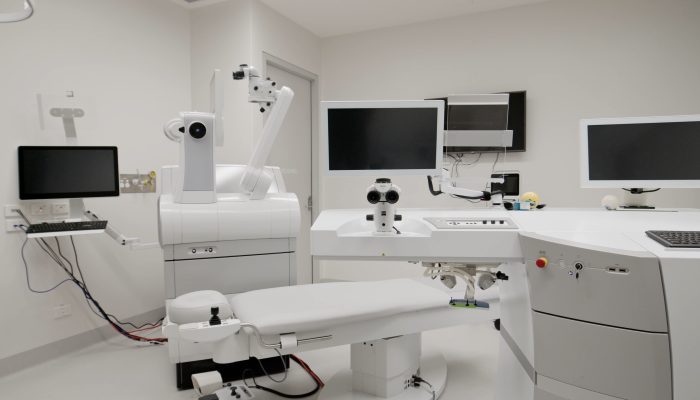
Wollongong Eye Specialists combine professional medical expertise with comprehensive and State-of-the-Art technology resources and equipment, allowing us to provide our patient community with the very best visual results.
Medical Director, Dr Smita Agarwal is committed to investing in the latest globally available State-of-the-Art technology and takes pride in providing it to the people of Illawarra and Shoalhaven. All our eye surgeons are highly qualified and experienced, regularly attending national and international conferences.
Read more about our suite of ophthalmic technology below.
Selective Laser Trabeculoplasty
Selective Laser Trabeculoplasty (SLT) is clinically proven to treat glaucoma by safely and effectively reducing intraocular pressure in a single, office procedure. SLT can be an effective addition to medication therapy or used as a primary treatment to reduce or eliminate the need for topical glaucoma medications.
YAG laser
YAG lasers are used in ophthalmology to correct posterior capsular opacification, a condition that may occur after cataract surgery, and for peripheral iridotomy in patients with acute angle-closure glaucoma, where it has superseded surgical iridectomy.
Pachymeter
Corneal Pachymetry is the process of measuring the thickness of the cornea. A Pachymeter is a medical device used to measure the thickness of the eye’s cornea. It is used to perform corneal pachymetry prior to LASIK surgery, for Keratoconus screening, LRI surgery, and is useful in screening for patients suspected of developing glaucoma.
ZEISS VisuMax 800 SMILE Pro
The ZEISS VISUMAX 800 SMILE Pro is a state-of-the-art femtosecond laser system designed for advanced refractive eye surgeries, particularly the SMILE (Small Incision Lenticule Extraction) procedure. Known for its precision and speed, the VISUMAX 800 operates at a high laser pulse rate of 2 MHz, which significantly reduces the treatment time while ensuring accurate tissue cutting and patient comfort.
Its ergonomic design includes a flexible docking system and a user-friendly interface, enhancing both patient and surgeon experience. Additionally, the system integrates ZEISS’s exceptional optics and laser technology to deliver consistent and high-quality results in correcting myopia and astigmatism. This cutting-edge device represents a leap forward in minimally invasive Laser Vision Correction.
Pentacam
The Pentacam is a rotating camera that photographs both the anterior (front) and posterior (back) surfaces and other areas of the cornea (the front part of the eye).
The Pentacam Scanner’s main advantage is that it provides more precise measurements of the central cornea than any other ocular measurement instrument currently available.
The Pentacam has improved the ability of eye physicians to diagnose ocular conditions, especially the eye condition known as keratoconus, more accurately than in the past.
iTrace
With iTrace, users can objectively “see what the patient sees” with a total quality of vision assessment. For the first time, eye care practitioners can truly understand, and better treat, vision complaints.
The iTrace can increase users’ confidence in vision analysis, even in difficult cases, with its highly accurate, state-of-the-art diagnostic information, improving efficiencies, saving time and avoiding mistakes. By identifying the origin of the aberrations through the unique analysis of lenticular verses corneal aberrations, users have more information and a better understanding of patient’s vision, and the structures affecting it and therefore can make better treatment decisions.
The ZEISS IOL Master 700
The ZEISS IOL Master 700 is a highly advanced optical biometer is designed for precise measurements in cataract surgery planning. It accurately calculates essential parameters such as axial length, corneal curvature, and anterior chamber depth, which are critical for selecting the correct intraocular lens (IOL) for each patient.
The IOL Master uses non-contact optical coherence interferometry, offering fast, comfortable, and highly reliable measurements. Its high level of precision helps optimize outcomes in cataract surgery, reducing postoperative refractive errors. The system also features an intuitive interface, making it easy for surgeons to perform quick preoperative assessments and streamline workflow in clinical practice.
The ZEISS Cirrhus 5000
The ZEISS Cirrus 5000 is a sophisticated optical coherence tomography (OCT) system used for detailed retinal imaging and glaucoma diagnostics. This high-performance device provides ultra-high resolution images of the retina, optic nerve, and macular regions, enabling early detection and monitoring of eye diseases like macular degeneration, diabetic retinopathy, and glaucoma.
With fast scan speeds and advanced data analysis capabilities, the Cirrus 5000 ensures accurate, reproducible measurements that help clinicians make informed treatment decisions. Its Smart HD scan patterns and real-time eye tracking improve image quality and reduce motion artifacts, delivering precise diagnostics with enhanced patient comfort.
Widely used in ophthalmology, the Cirrus 5000 is a trusted tool for managing complex retinal conditions.
MS-39
The MS-39 is a highly advanced diagnostic device used in ophthalmology, specifically for corneal analysis and anterior segment imaging. It combines two powerful imaging technologies:
- Anterior Segment Optical Coherence Tomography (AS-OCT): A non-invasive imaging method that provides detailed, cross-sectional views of the cornea, anterior chamber, and other structures in the front part of the eye.
- Placido Disk Topography: A technology that analyses the shape and curvature of the corneal surface by reflecting a series of concentric rings onto the cornea. It helps assess the corneal contour in great detail.
The MS-39 provides comprehensive information about the cornea and anterior eye structures, making it valuable for diagnosing and managing various eye conditions, such as keratoconus, corneal ectasia, and refractive surgery planning.
Humphrey Visual Field Analyser (HFA)
Wollongong Eye Specialists has the latest version of the Humphrey Visual Field Analyser (HFA) which is a diagnostic tool used to assess a patient’s visual field, particularly to detect and monitor peripheral vision loss.
It is widely used in the diagnosis and management of glaucoma, as well as in detecting visual field defects caused by optic nerve damage, retinal diseases, and neurological conditions like stroke or brain tumours.
The HFA provides detailed information about blind spots and areas of vision loss, helping ophthalmologists track disease progression and the effectiveness of treatments.
ZEISS Visucam
The ZEISS Visucam is a diagnostic device used to capture detailed images of the retina, the back part of the eye that includes the optic nerve, blood vessels, and macula.
Its primary purpose is to help ophthalmologists detect, diagnose, and monitor a variety of retinal conditions such as diabetic retinopathy, macular degeneration, and glaucoma.
By producing high-resolution images, the camera allows for precise documentation of retinal changes over time, aiding in early detection and management of eye diseases, as well as facilitating patient education and treatment planning.
ZEISS Mel 90 - advanced excimer laser technology
A ZEISS MEL 90 specialty is the Triple-A Advanced Ablation Algorithm. It is a single ablation profile for a wide range of sphero-cylindrical (SCA) corrections that simplifies treatment planning. Triple-A offers a high degree of precision, reproducibility and predictability, as well as advantages such as the controlled induction of spherical aberrations and tissue-saving ablation.
Its preinstalled functions also offer surgeons optimal support for achieving excellent treatment results and gentle treatments of standard, higher and lower level of ametropia as well as astigmatism. These features ensure a successful treatment of the following procedures: Femto-LASIK, LASIK, LASEK, PRK and PTK.
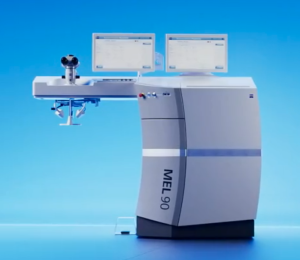 Fast ablation speed
Fast ablation speed
With its unique FLEXIQUENCE switch function (250 Hz and 500 Hz operation) and additional configuration options, the ZEISS MEL 90 is a true customised power package. When performing LASIK for myopia at 500 Hz, the ZEISS MEL 90 can intra-operatively ablate 1 diopter in as little as 1.3 seconds. The same short treatment time and full laser speed also apply for treatments of presbyopic patients with PRESBYOND.
Intuitive system guidance and speedy treatment planning allow for additional time savings. The ZEISS MEL 90 excimer laser technology is equipped with an active eye tracker which has an excellent response time, providing a high level of treatment safety with very stable results. The advantageous FLEXIQUENCE function is properly supported by the adaptive sensor-controlled CCA+ plume removal system.
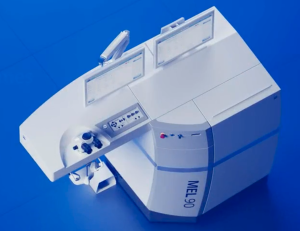 Easy to use
Easy to use
As a true team player, the ZEISS MEL 90 excimer laser greatly simplifies the interactions between the surgeon, the assisting staff and the system technology. The excimer laser can be configured to precisely match the surgeon and OR team`s needs. The ZEISS MEL 90 is a highly reliable system requiring very little service maintenance. The system’s simple, intuitive graphic user interface supports fast treatment procedures. The new MEL 90 patient bed LS Comfort 80 combi enables the combination with the next evolution of femtosecond lasers VISUMAX 600 or VISUMAX® 800.
High-quality equipment for an optimized workflow
The touch screen can be flexibly positioned wherever it is needed and provides the surgeon with a good ergonomic sitting posture throughout the operation. A second, optional touch screen allows the assistant to start preparing the next therapy while the surgeon is still concluding post-operative care for the previous treatment. An HD video port, network printer connection and PDF export capabilities offer additional workflow support. With the proven fluence test, laser calibration is very quick and easy.
Furthermore, the workflow-optimised compatibility of the MEL 90, VisuMax® , VISUMAX 800, and CRS-Master® and Refractive Workplace®from ZEISS ensures a high level of consistency.
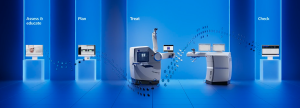
Digitally connected to ZEISS Refractive Workplace
Treatment plans for LASIK, PRK, femtosecond LASIK or treatments with PRESBYOND can be created with ZEISS Refractive Workplace and transferred simply by network connection. The MEL 90’s connectivity to FORUM® enables remote treatment planning outside the operating room. You can also store treatment protocols and videos in network storage locations and the FORUM archive for documentation and review or directly request technical service support. In addition to that, the excimer laser automatically delivers device status information like log files to the central device management system via a remote service connection.
ZEISS CRS Master
The CRS-Master® from ZEISS is a flexible and efficient remote treatment planning station for conventional and customised laser vision corrections, including LASIK, Femto-LASIK, PRK and LASEK. It also enables age-related binocular treatment planning for presbyopic patients using PRESBYOND® Laser Blended Vision from ZEISS.
Alcon Unity VCS (Vitreoretinal Cataract System)
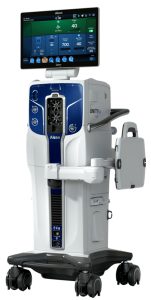 The Alcon Unity™ VCS (Vitreoretinal Cataract System) is an advanced surgical platform designed to streamline and enhance both cataract and vitreoretinal procedures.
The Alcon Unity™ VCS (Vitreoretinal Cataract System) is an advanced surgical platform designed to streamline and enhance both cataract and vitreoretinal procedures.
By unifying key technologies into a single system, it provides surgeons with improved control, precision, and efficiency during complex ophthalmic surgeries. Its purpose is to support seamless transitions between anterior and posterior segment procedures, helping deliver better patient outcomes through cutting-edge fluidics, visualization, and energy delivery systems.


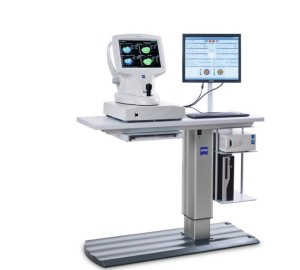 Topography-guided customized treatment
Topography-guided customized treatment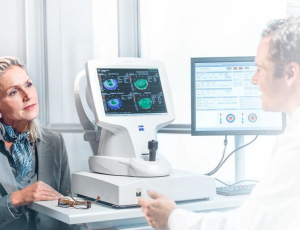 Integrated diagnostics for refractive treatment
Integrated diagnostics for refractive treatment